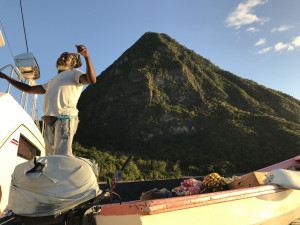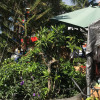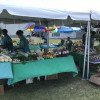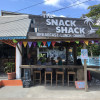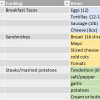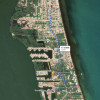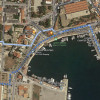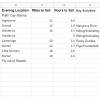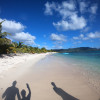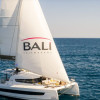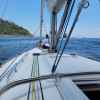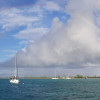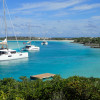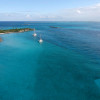As the name implies, bareboat cruising starts off with barren cupboards, refrigerators and freezers. Figuring out what, and how to provision your boat that may be hundreds or thousands of miles from home can be a daunting task. I intend to help get you pointed in the right direction.
What will you need to provision?
The first thing everyone thinks of is food/water/booze; and while all of these things are key, there are several other things you will need to make the bareboat your home for your journey. Ask your charter company what will be included with the boat; in most cases, you will be provided with bedding, basic kitchen equipment, and not much more. Do not forget things like trash bags, Ziplocks, cleaning products (soap, sponges, paper towels), and toilet paper. Make sure it is marine TP, for your own sake!
Do the math!
Eyeballing it is normally fine when shopping at home. If you get too much, you have the space to store it, if you do not get enough, you can be back in a supermarket in just a few moments. These yachts typically have small refrigerators, freezers, and limited storage space. Also, things add up more quickly than you might think. An 8-person boat, with each person drinking just 3 soft drinks or beers a day will burn through a full case in a single day. One round of sandwiches underway can easily go through a loaf of bread using 16 slices or more. Water also adds up quickly if you will be drinking and cooking with water you bring aboard.
Know the plan-
I recommend that you get your itinerary as close to nailed down as possible before planning your provisions. A solid itinerary will make it easy to determine what meals your crew may be eating on shore, on anchor, and/or underway. Strong research online, with your charter company, and sailing guides will help make sure you have an accurate understanding of what bars, restaurants, and other off boat options may be available along the way.
Tip- Things spoil! You may have trouble keeping bread from molding over during a weeklong trip. Unrefrigerated fruit is also at risk in the warm and humid air. Refrigerated (not frozen) fish and meat may be better consumed on the front end of the journey.
Time to start putting a menu and shopping list together-
Break out each meal item by item, and be sure to remember that your boat will not have any spices or condiments already onboard. I like to end up with a spreadsheet that has everything listed out for every meal so that I can easily keep track of what I am able to provision before arrival, what I may need to bring with me, and what I may need to try to find locally.
Tip- Try to incorporate things that do not take up much space, and/or require refrigeration. If you can restock ice along the way, an extra cooler or two can be a lifesaver.
Where to provision-
Many charter companies will offer online grocery deliver service to your yacht prior to departure. The good news here is that you can have most, if not all of your provisioning delivered to your boat, just prior to setting sail. The bad news is that is likely more expensive than some of the other options, and if you are picky about some items like fruits and vegetables, you may have to accept whatever shows up. Example from the Moorings
Talk to your charter company, and poke around on Google Maps to see what the local grocery store/markets are like. You may find options within walking distance or a quick cab ride from your base. This is normally the most cost effective, but can be tricky if your timeline between arrival and setting sail are close. A delayed flight can easily cut into your working time. Also, you run the risk of not being able to find something you had in the plan or on the menu.
Bring a few provisions with you- I normally take at least one cooler with us when I charter, and I take advantage of that space to take some provisions. I like to take a few things that I know I can get at a good price and are high quality along with me. I often use Costco or Sam’s Club for steaks, sausages, cheese etc. Keep everything in retail packaging (don't bring home cooked things in a plastic container), and use ice packs to keep everything cold. Dry ice prohibited, and in most cases bagged/liquid ice is as well. You can significantly save money bringing a few things, but there is always a slight risk of trouble with the airlines or customs folks. You also will have to deal with the hassle of lugging a cooler through the airport.
Tip- Understand the requirements from the airlines and TSA for traveling with a cooler, and remember that even small coolers can reach the baggage weight limit easily.
Pick up some things along your journey. This one requires a little bit of local research. In some places it can be quite easy to find places to provision or top up throughout your trip. In other destinations provisioning along the way can be impossible or extremely limited.
Tip- Have a simple backup meal. It can be hard to know for sure if that one place to eat in that secluded anchorage will be open when you arrive; or that ground beef you were going to use for burgers on day 8 may not be looking so hot. For 5 bucks a dry package of pasta and can of sauce can save the day, not require refrigeration, cost under 5 dollars, and takes up little space.
On the water- In the right place and in the right season you may have the opportunity to buy fresh fish, lobster, or prawns right from a local in a boat.
Duty Free- For alcohol, some locations can be double or triple the price for your favorite elixir; consider having all onboard take advantage of duty free at the airport.
It can be daunting to think of trying to have as much, if not all of the things you will need for a long voyage provisioned and ready to go from day one of your journey. The challenges of a small galley with small fridge/freezers and limited storage area can take some getting used to! Not being able to just run up to the store for a missing item, or drive down the road to the next restaurant is all part of the adventure. This really is a key part of your charter, and if you take a little bit of time to research your location, plan and do the math, you can take much of the stress out of the process.

